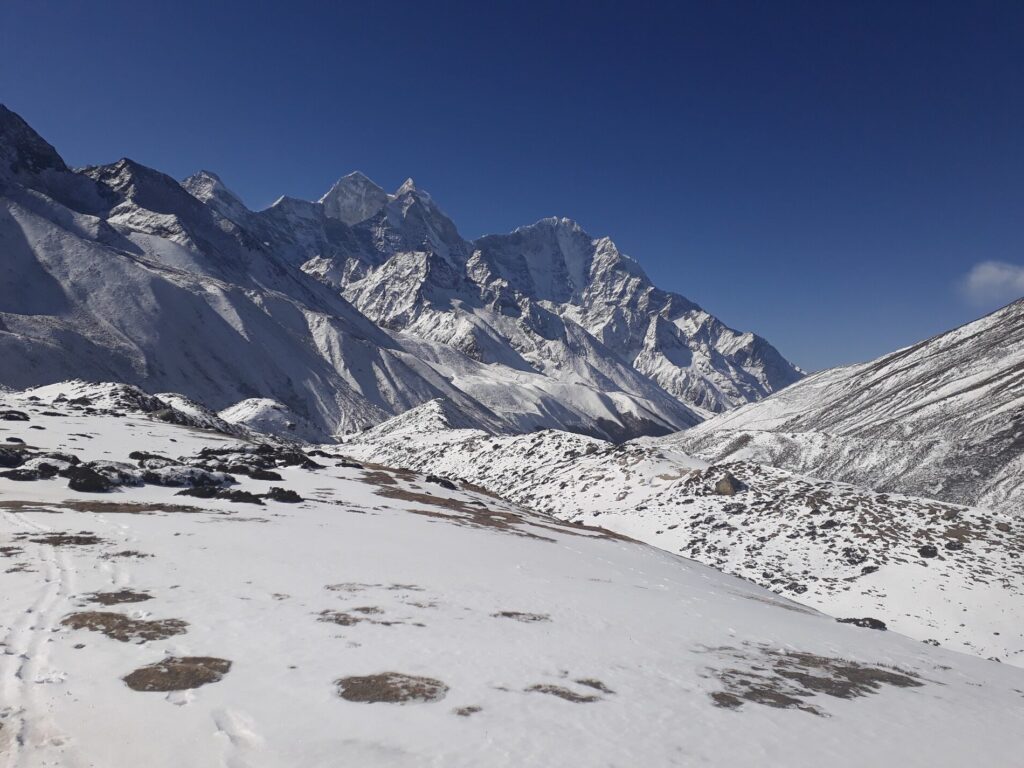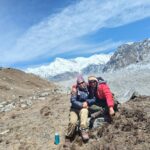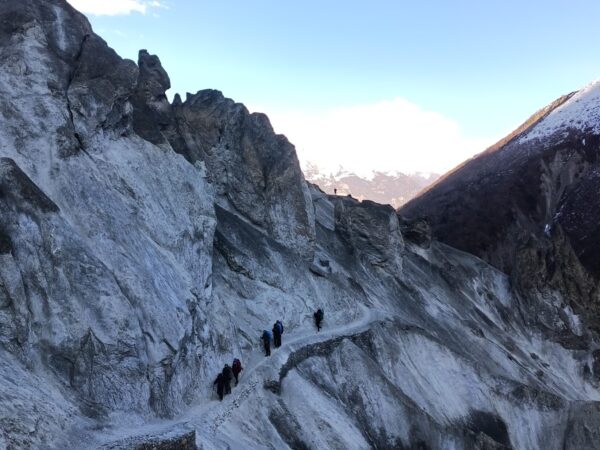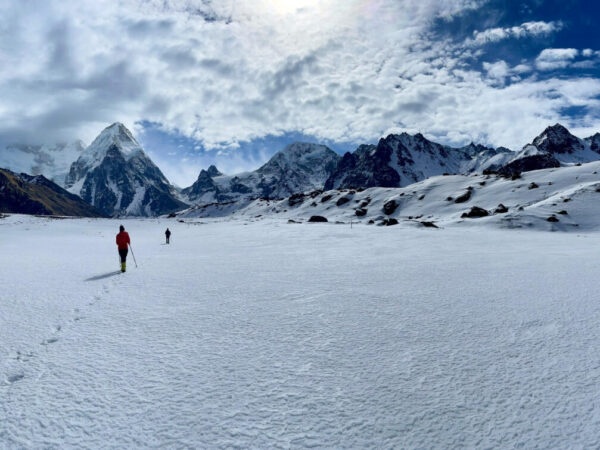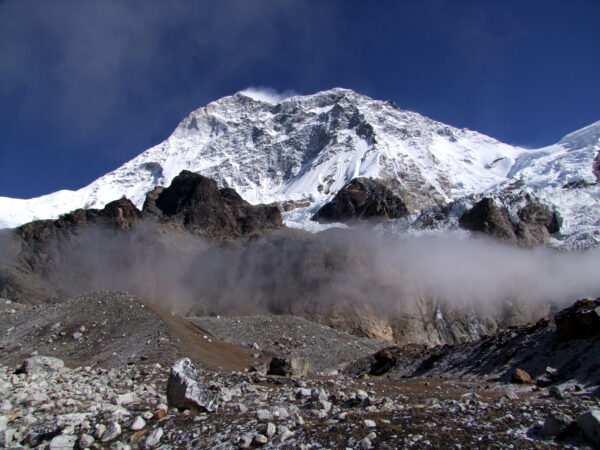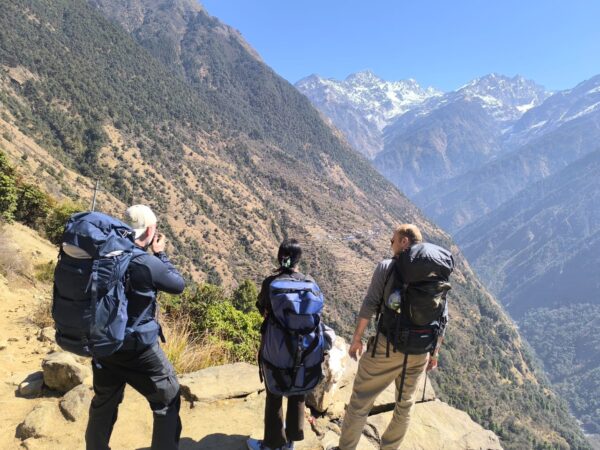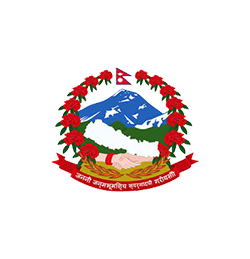Highlights
- You're going to have a chance to capture breathtaking horizon views of the world's towering peaks among which are highest of them all, i.e. Everest, Lhotse, Nuptse, Makalu, and Cho Oyu.
- The trek involves crossing three high mountain passes: Renjo (La) Pass (5360m), Cheo (La) Pass (5420m), and Kangma (La) Pass (5535m), each offering breathtaking scenery and a sense of having done something wonderful.
- The walk will lead you to isolated Gokyo Lakes which are the turquoise glacial lakes amidst towering peaks. Such lakes with Mt. Cho Oyu in the background bring in the atmosphere that is soothing alongside the atmosphere of freshness.
- When you crawl up the trail of Gokyo Ri (5,357m) you will get the chance to witness one of the most breathtaking landscapes views in the whole Everest region.
- This journey also carriers you to Everest Base Camp (5,364m) where you can not only feel its presence but also enjoy the nice atmosphere surrounding it.
- Climbing up to Kalapatthar (5,550m) helps a traveler experience a good view of Mount Everest. Sunrise here is even more amazing.
- While traveling, you'll also have the ability to step into Sherpa community and explore most famous Sherpa settlements - Namche Bazaar, Khumjung and Thame, learning about daily life.
- Rhododendron forests and alpine meadows are just two of the many different scenes that will capture your attention. And through it all, you will have rugged glaciers and towering peaks that never let you down.
- Most of the trek is conducted in a remote and pure countryside, which gives you the feel of adventurism and solitude while staring at the majestic scene of snow-clad mountains.
- Doing the Three High Passes Trek in the Everest surely is a remarkable personal accomplishment. This is a challenging task demanding physical resistance, psychical endurance, and the spirit of adventure, to induce a welcoming and meaningful experience for hikers.
Overview
The Everest Three Pass Trek is an epic adventure that involves crossing three incredibly high-altitude passes: Renjo-La pass, Cho La pass, and Khongma-La pass. Accordingly, these passes rise up and hold the most dramatic altitude, ensuring that you enjoy the views of your awe-inspiring surrounding scenery.
Hiking duration for a trek is long, up to 9 hours, with some uphill ascents adding difficulty to the level of fitness. however this is not that desirable spot for the chilly hearts, but it’s a great journey for the adventures.
Starting from Lukla, trekkers can choose between two routes: spinning clockwise or counterclockwise. In any case, regardless of the path you take, you are sure to be rewarded with equally breathtaking sceneries and landscapes.
Renjo La Pass for short is at 5,464 meters above sea level. Despite this –the vision of Mount Everest among the other mountains and the Gokyo Lake , which is, by its beauty, mesmerizing is simply breathtaking. Plenty of people claim the views from here are better than from the Kalapatthar.
A Cho La Pass prefers climbers very much. It is dynamic between Lobuche and Cholatse, and it is very difficult and is a challenge. Here and now the ice-covered and steep ways, relatively cramped in this case, become a perfect arena for the climbers to taste different moments of triumph and reaffirm their efforts to reach the top.
Contrary to other passes, the Khongma La will certainly offer its own pieces of surprise and challenge; with cold, demanding weather conditions, where glaciers and high rivers need to be crossed as part of the climb. On this trip, going all way up to the thin air at the top of the mountain 5,535 meters high will be our starting point. I am one-hundred percent sure that these majestic mountains add to our expedition, and therefore, it’s worth every ounce of effort put to seeking to see all these beauties from the highest point.
And it is all about the psychological endurance that the mountains require, not defeating the whole geography of mountains. Its many take pride spots are none other than advent trophy Everest Base Camp, Namche Bazaar, Tengboche Monastery and the beautiful Gokyo Lakes. This is a biotope that is to describe the fourth point when hikers there and now physically and figuratively realize that they are not fit for the situation and instead they are to accept their feelings and the real state of fact.
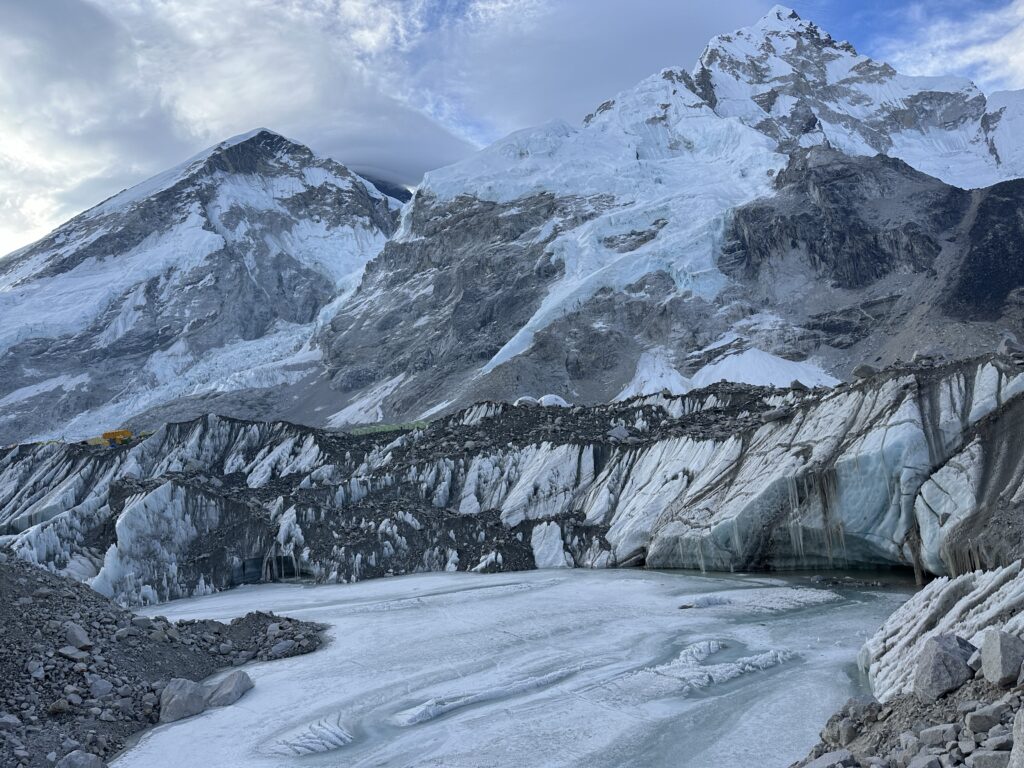
Tengboche Monastery, located in the Kumbu Region, Kingdom of the Himalaya, unlines the two aspects that constitute your corporeality. You get a chance to leave the worries of the outer world behind as you forget about everything about your difficulties. These spots are different from the high freshwater lakes of Gokyo Lakes, which instead bring change to the scene and offer a new perspective of the mountains.
These hikes are not exquisite for some people, but they also wish to relive the ancient memories, thus the perfect opportunity for them. It is also a name for Everest helicopter tour. Thus, there is an opportunity to view the natural heritage of the mountains from above, which means that there will be no problem such as being fit to hike in the mountains.
Basically, Everest Three Pass is, in a sense, the pinnacle dream trip for those who have the ultimate love for the outdoor activities and nature, stunningly located in the midst of the Himalayas.
How to prepare before flying to trek Everest Three High Passes ?
Every traveler needs to prepare prior to the trip considering the necessities. At least 1-month advance is required as the traveler can think properly about what to do or not.
- When to trek ? Basically, March to May and September to November are the best time to trek.
- Join a group or go private ?
- What to pack ?
- Hire guide and porter ?
- Where to acclimatize and how many days ? At least 2 days’ acclimatization are recommended. You can rest in Namche. Meanwhile, you can hike to Everest View Hotel and enjoy the pretty awesome scenery of Ama Dablam Mountain and the Mt. Everest. And the second acclimatization day in Gokyo Valley would be suitable.
- Should I buy package trip that includes foods as well ? Or pay myself ?
- What permits are required ?
- How long hours should I walk each day ?
- Probabilities of high altitude sickness
- Required days for this trekking ?
- What kind of gears should I bring ?
Find the 5 best itineraries for Everest Trekking
Best Time for Everest Three High Passes Trek
Picking that when to trek Everest Three High Passes Trek and Annapurna Base Camp Trek among others usually touch on elements such as preferred weather, trekking expertise, and perfect scenery.
Peak season for Annapurna Base Camp Trek is September to November during Autumn. These months are the most recommendable for that route. The trekkers have all three options but the wet and cold are the downsides of walking in Spring (March to May).
The trekkers have to see ahead what this trek has to offer by keeping their eyes wide open. Similarly, in this region, the weather is expected to be fairly constant given clear skies,
which therefore keep the temperatures moderate allowing trekking through the forests and meadows with a snow-capped peak of the Annapurna range.
Likewise, the Everest Three High Passes Trek can go in spring and autumn seasons just as the other routes. Also seasons do have the weather perks at these periods of the year.
Nevertheless, there are some aspects that one has to bear in mind though like higher altitude, uneven trails, and traversing the difficult passes are all contingent on weather condition especially when you consider climbing them.
So, here hikers should pay special attention to the season of the trip to realize the trip in the appropriate time when the harsh climate of the Himalayas won’t destroy the mood of nature admirers.
Finally, hikes across those peaks gives idea of the beauty of Nepalese mountains with their own merits and demerits, so the choice of the best season is not so easy for everyone who wants to find something special.
Difficulty in Everest Three High Passes Trek
Everest Three High Passes Trek in Nepal is very challenging journey – you should be prepared to spend from 19 to 23 days in the high mountains. Trekkers tackle three daunting high mountain passes: Kongma La at 5806 meters, Cho La at 5367 meters, and Renjo La at 5388 meters from the sea level. The expedition requires adaptation to the extreme climatic conditions, high altitude acclimatization and the most of all, strong means of mental and physical health.
Trekkers, more often than not, have to endure hardships of strained weather conditions, undulating terrain, and minimum amenities which will necessitate carrying a lot of rations in case of emergencies as well as other intangible attributes. The hardest part of the trek is without doubt the river crossing, but the incredible scenery of the Himalayas mean the feeling of success afterwards is indescribable. The most important thing is the preparation such as physical training and using the guides who know the area because only in this way mountain climb will bring pleasure and safety.
Physical Fitness required in Everest Three High Passes Trek
Taking on The Everest Three High Passes Trek, then, requires you to possess super endurance to cope with the extra hardy nature and expansive high altitudes. Cardiovascular performance to the top level, muscle strength, and stamina for the steep ascents and descents, are required for the trekking at the altitudes of 5000 meters or higher. Remember that flexibility with a perfect balance is no exception to injury prevention, however, seek for some skills that are necessary for your acclimatization during the great height and mental resilience that is important for living in places that are aprofound or remote and unpredictable. A comprehensive training program comprising of cardiovascular exercise, strength training and utilizing altitude simulators can help one to adequately prepare for this adventurous adventure.
Trekking Permits and Travel Insurance for Everest Three High Passes Trek
It is a must-to-do for every trekker who wishes to have a memorable and stress-free journey experience to need to secure a trekking permit before embarking on the Everest Three High Passes Trek. Permits usually are entrance permit to the national park of Sagarmatha and the Khumbu Pasang Lhamu fee for the municipality. These passes will also be certified, lead to a proper entry of the area, and secure its conservation. Hence, travel insurance that covers all facets of a trip should also be purchased. This insurance should cover shipment evacuation for illness or injury, trip cancellation, and unexpected events. It relives you of both peace of mind and fiscal safeguard from any unpredicted events which may be present through the atypical voyage in the Himalayan Mountains.
Food and Accommodation in Everest Three High Passes Trek
Don’t expect star-level accommodation in the mountain region. Only lodges and teahouses are available on the trail. However, you don’t need to stay camping as it is a teahouse trek. All of the teahouses offer food and overnight stay. Some of them do have a luxury room with an attached bathroom while many don’t have. Basically, you will have the option to choose between a twin-shared room or a private room for more luxury. In some teahouses, a hot shower is also provided with extra charge.
Food is served in teahouses where you can get a few options of meal to choose like Typical Nepali cuisine to Continental Foods.
Packing List for Everest Three High Passes Trek
If you have already trekked in Nepal, then you must have general ideas about the packing list for trekking in Nepal. But if you are a novice trekker in Nepal, then you must be aware of the packing list.
Basically, a couple of trousers and tee shirts along with thick socks for cold, good quality down jacket, sleeping bag, and a hiking stick are required to have for trekking in Everest Three High Passes. Moreover, you should not forget to bring hiking boots. For detail about the packing list, you can follow the below link
What should I pack to trek in Nepal?
Outline Itinerary
Day 01: Fly Kathmandu to Lukla (2,840m), trek to Phakding (2,610m) [3-4 hrs]
Day 02: Trek to Namche Bazaar (3,440m) [5-6 hrs]
Day 03: Acclimatization in Namche (3,440m)
Day 04: Trek to Tengboche (3,860m) [5-6 hrs]
Day 05: Trek to Dingboche (4,410m) [5-6 hrs]
Day 06: Acclimatization in Dingboche (4,410m)
Day 07: Trek to Lobuche (4,910m) via Kongma La (5,535m) [7-8 hrs]
Day 08: Trek to Gorakshep (5,164m), hike Kala Patthar (5,545m)
Day 09: Trek to Dzongla (4,830m) via EBC (5,364m) [6-7 hrs]
Day 10: Trek to Gokyo (4,750m) via Cho La (5,420m) [7-8 hrs]
Day 11: Acclimatization in Gokyo (4,750m)
Day 12: Trek to Marlung (4,210m) via Renjo La (5,360m) [6-7 hrs]
Day 13: Trek to Namche (3,440m) [5-6 hrs]
Day 14: Trek to Lukla (2,840m) [6-7 hrs]
Day 15: Fly to Kathmandu
Everest Three High Passes Trek – 15 Days - Itinerary
Fly Kathmandu to Lukla (2,840m), trek to Phakding (2,610m) [3-4 hrs]
Start your day with an early awakening to board an aircraft that is poised to carry you through the flying realm of tall mountains, to reach the airport that is located at the top of the world. Upon your arrival, you are welcomed by field crew and you admire the magnificent airstrip hidden in the toe of the peaks. Thereafter, is your time to begin on the path that will lead you to a monastery, a suspension bridge, and right into the middle of the Sherpa community. We stop for the first night at Phakding, about a 3 hour’s hike from Lukla.
Trek to Namche Bazaar (3,440m) [5-6 hrs]
After an invigorating breakfast, set out to explore a scenic hiking trail featuring a climbing and downhill section, arriving in the famous market town of Namche Bazaar. During your travel, you need to space through the gate of Sagarmatha National Park, manage suspension bridges, and spend the day in the dense forests filled with wonderful rhododendron flowers. It’s Namche Bazaar village that we are at today, the biggest Sherpa area in the region, packed with trekkers and climbers as well as local people who are busy with their daily routines.
Acclimatization in Namche (3,440m)
Today is all about acclimatizing our bodies to the soaring heights. We only just reached here, after all, so we need time to acclimatize. Walking around Namche or taking a short walk in the area is all that matters as long as you stay active. One awesome suggestion would be to go to the Everest View Hotel at the break of dawn for cup of coffee. There, you will likely find people who have parked there for helicopter ride to this spot at the Everest as they enjoy the much coveted breakfast with a view of Mt. Everest. Another possibility towards the village of Khumjung sees many beautiful sites like the Khunde Hospital and the Khumjung School, both launched in the fifties by Sir Edmund Hillary. Khumjung Monastery is of great religious and cultural value to the people of the Sherpa community whereby it should be part of the list of the things that should not be missed out off. According to the legend, a Yeti scalp is preserved inside the jar, arguably making it all more confusing and exciting. Lastly, remember to grab anything you’ll need for the way ahead, snacks being your last store chance since there are no stops throughout the road journey.
Trek to Tengboche (3,860m) [5-6 hrs]
Tengboche village supports one of the holiest monasteries worldwide, delighting the visitors observe the Everest and Lhotse peaks. This Hike commences with a crossing of the Dudh Koshi River followed with a trek in dense forest and latter as you ascend above tree line. The route runs through a monastery with Buddhist dominance, therefore, you will find stuffs such as stupas and prayer walls. Apart from the prayer sessions with monks, the extraordinary scenery that invites the visitors to unwind in the village overnight is also a source of contentment.
Trek to Dingboche (4,410m) [5-6 hrs]
The track is rugged, and the route between the two villages (Tengboche and Dingboche) without any trees is windy. While the huge rock mass of Ama Dablam shadows over the path of the trail which winds it way through the Imja Valley down to the Lobuche River following which the path then climbs steeply up to Dingboche. This small but quite town has fields that are surrounded by stone barriers hence protect high altitude crops from winds of stronger intensity and livestocks grazing . Besides, a lot of lodges are situated here all over the area.
Acclimatization in Dingboche (4,410m)
A hike to Nagarjun Hill will definitely accomplish two things – acclimatization and being awed by the stunning vistas! You will be at 5,100 meters where an outlook will be stunning that shows valleys like in Periche with peaks touching the sky like Mount Ama Dablam, Thamserku, Lobuche East, and Lobuche West. I am certain that you will remember every single detail from this experience and you will be able to experience the cinematographic scenery of Himalayas more than ever before. It is important to always remember to take things easy, drink enough water, and have a good time on your journey.
Trek to Lobuche (4,910m) via Kongma La (5,535m) [7-8 hrs]
Well, it has been a long but surely an exciting and mindful day. Our trip started with a climbing ascent out of the valley and towards Dugla which is located on the moraine of the lower part of the Khumbu Glacier to reach Chukpo Lari. At that moment, we unexpectedly found solemn memorials dedicated to climber who died on the way to the top, monumentally set against the stunning background of the thundering mountain range lying between Nepal and Tibet.
Today’s high experience has been exceeding the tough Kongma La Pass, gaining in height at 5,545 m above sea level. From this special position, we could see various mountain ranges with Lobuche, Mehra being the closest to us, as well as the big Nuptse south face and other to-remember-for mountain peaks. Our guide full of knowledge drew our attention along the way to these landmarks as well. The altitude of the pass we will be crossing is very demanding and underlines the acclimatization days which we have done before.
Trek to Gorakshep (5,164m), hike Kala Patthar (5,545m)
The trail in Lobuche is gradual and mild from which it takes almost three hours to Gorakshep. On arrival, we settle into our lodge and have lunch before we take on a hike going to Kala Patthar, the top point of view of the Everests. To a certain extent, the Everest Base Camp is popular, although there is absolutely no comparison with Kala Pathhar especially because of its location and the view of the Everest. The latter proves to be a unique witnessing point of the height of the Everest that cannot be explained until it’s seems by the eye. Besides that, we go over to Gorakshep and spend an overnight.
Trek to Dzongla (4,830m) via EBC (5,364m) [6-7 hrs]
Leaving Gorakshep in the early morning, we wander through Khumbu Glacier; frost-glazed mountains and peaks together the eastward move to the Everest Base Camp. Often so, this famous place is not the usual site where mountaineering groups send their expeditions. We can see their bright tents near us but at the same distance from us, to be sure they do not interfere with their arduous preparations. At Gorakshep, the breakfast is served and we further head to Dzongla where we spend the night.
Trek to Gokyo (4,750m) via Cho La (5,420m) [7-8 hrs]
Early enough we began our way up Cho La Pass, famous with its glacier and picturesque views. The expedition starts off with a calm trail, gently stone-by-stone climbing towards the majestic view of Ama Dablam and other icy peaks, deep valleys, and extensive glaciers. The landscape becomes difficult with loose stones and we have to be very careful in order to get to the glacier’s edge. In the event above, the use of crampons is compulsory (buy or hire crampons in Thamel, Kathmandu before the trek). Amidst the backdrop of a distant turquoise lake, we continue our ascent, pausing at the pass adorned with fluttering prayer flags for rest and memorable photo opportunities.
After descending from the pass, we will, somehow, manage to steer towards Thagnak village, absolutely not allowed to miss the lunch-break, and cross a glacier before Gokyo, where we will finally spend the night.
Acclimatization in Gokyo (4,750m)
It is another acclimatization day at Gokyo. This is a great opportunity to discover the Gokyo village and its’ area.
Trek to Marlung (4,210m) via Renjo La (5,360m) [6-7 hrs]
Our expedition begins early as we hike the splendid mountain peaks of Nuptse, Lhotse and Everest, along with other high altitude mountains. We come down through a narrow valley of stone steps to the base. On the journey, we do meet at first the Renjo Lake and after follow the Dudh Pokhari (lake). Expansive vistas including that of the third Gokyo Lake, Gokyo village, and Ngozumpa Glacier will unveil when you hike across Renjo La Pass with Mt. Everest towering over all. Another example is we come across Relama Tsho and Renjo lakes on our descent to Marlung and pass by the Bhote Koshi River.
Trek to Namche (3,440m) [5-6 hrs]
Finish your hike with a smile as the compelling view bears down on you at the end your walk today. The trek goes downwards towards Thame village, and the path travels across the Bhote Koshi River and several bridges during this journey. The monastery at Thame sits on a hillside above the village with its fine views of it. The downhill trek comes to an end in Namche Bazaar where you have just arrived.
Trek to Lukla (2,840m) [6-7 hrs]
Today we trace the path of Dudh Koshi River, which took us to the Lukla helipad where we were overnighting before taking the flight back to the capital.
Fly to Kathmandu
However, this flying trip will as well provide breathtaking sights of the beauty! Upon the arrival at Kathmandu, our air flight would passage all the famous landmarks namely mountains and farming fields, and the journey of flight would reach its end in the busy Kathmandu city. On our reception, we will go along with you to your hotel and share with you things to do, which you can do in that evening.
Inclusions
What's included
- International & Domestics Airport pick up and drop
- 2 Nights Standard Hotel accommodation in Kathmandu (with breakfast included)
- An Experience English speaking guide and porter (1 porter for every 2 trekkers)
- All Meals and Teahouse accommodation during the trek
- Kathmandu to Lukla Flight Ticket (Round Trip)
- All required trekking permits (Sagarmatha National Park Entry Fee and Khumbu Rural Municipality Entry Fee)
- Guide insurance with food and accommodation
- Basic Medical kits
- Sleeping and duffel bag, down jacket, trekking poles (should be returned after the trek)
- Emergency Helicopter Evacuation Service Arrangement Only (should cover by your travel insurance)
- All required paper works and government taxes
- Farewell dinner
What's not included
- International Flight
- Nepal Travel Visa Fee
- Personal Medical and Travel insurance (Should cover helicopter evacuation)
- Guide, Porter and Driver tips
- Personal Gears (equipment)
- Personal bill
- Lunch and Dinner in Kathmandu
- All other personal expense of beverages (hard and soft drinks)
- All other things not mentioned in the inclusion.
Route Map
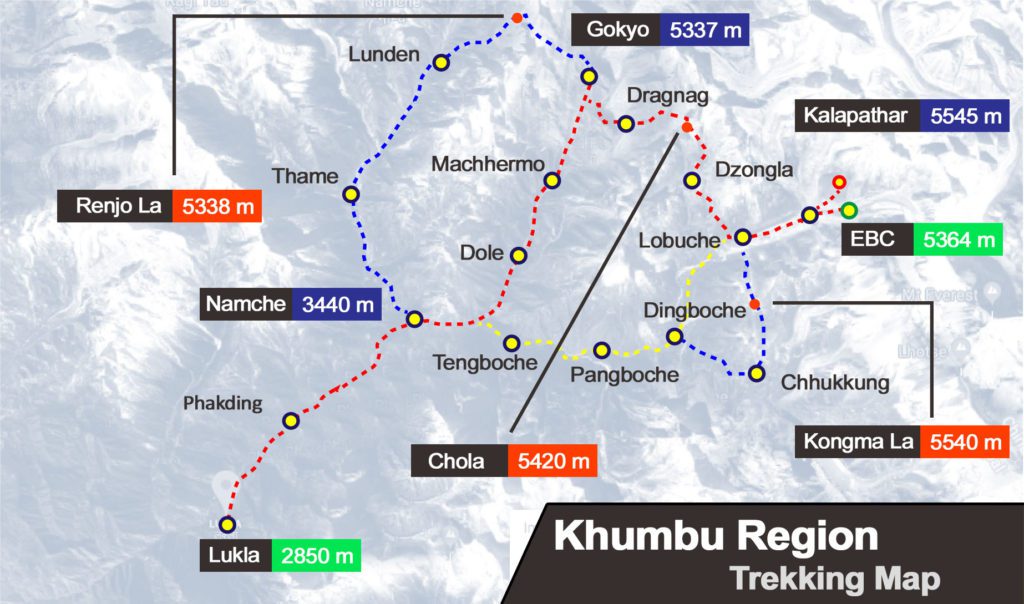
Altitude Chart
Equipment
Recommended Trekking Gears
Clothing
- Base Layers (Moisture-Wicking)
- Thermal tops and bottoms (polyester or merino wool)
- Lightweight long-sleeve shirts
- Insulating Layers
- Fleece jacket or pullover
- Down jacket (for high-altitude treks)
- Warm sweaters
- Outer Layers (Shells)
- Waterproof and windproof jacket (Gore-Tex or similar)
- Waterproof pants
- Trekking Pants
- Quick-dry pants
- Convertible hiking pants (zip-off into shorts)
- Trekking Shirts
- Lightweight and breathable T-shirts
- Long-sleeve shirts with UV protection
- Headwear
- Wide-brim hat or cap for sun protection
- Warm beanie for cold temperatures
- Buff or scarf for dust and wind
- Gloves
- Lightweight trekking gloves
- Insulated gloves for higher altitudes
- Socks
- Moisture-wicking trekking socks
- Thermal socks for colder regions
- Footwear
- Sturdy and waterproof trekking boots (well broken-in)
- Comfortable sandals or camp shoes (for evenings/rest days)
- Gaiters (optional, for snow or muddy trails)
Backpacks & Bags
- Backpack
- 40-50L capacity for multi-day treks
- Comfortable straps and rain cover
- Daypack
- 20-30L for short treks or carrying essentials during the day
- Duffel Bag
- Used if porters are carrying your gear (for organized treks)
- Dry Bags
- To keep electronics and clothes dry in wet conditions
Sleeping Gear
- Sleeping Bag
- 4-season sleeping bag (rated for -10°C to -20°C for high-altitude treks)
- Sleeping bag liner (optional, for extra warmth and hygiene)
- Sleeping Pad (if camping)
- Lightweight and inflatable or foam pads for comfort
Trekking Accessories
- Trekking Poles
- Adjustable and lightweight poles (essential for steep ascents/descents)
- Water Bottle/Hydration System
- Insulated bottle (to prevent freezing at high altitudes)
- CamelBak or similar hydration reservoir
- Water Purification
- Water filters, purification tablets, or UV sterilizers
- Sunglasses
- UV protection (Category 3 or 4 for snowy conditions)
- Headlamp
- With spare batteries (essential for early morning or late-night treks)
- Multi-tool or Knife
- For various small tasks
- First Aid Kit
- Bandages, blister patches, antiseptic wipes, painkillers, Diamox (for altitude sickness), etc.
- Lip Balm
- SPF-protected to prevent chapping
- Sunscreen
- High SPF for UV protection at higher altitudes
- Personal Toiletries
- Biodegradable soap, toothpaste, toothbrush, quick-dry towel, wet wipes, and toilet paper
Optional but Useful Items
- Camera
- To capture the stunning scenery (extra batteries and memory cards are a must)
- Snacks
- Energy bars, trail mix, or chocolate for quick energy boosts
- Power Bank/Solar Charger
- For charging devices in remote areas
- Books or E-Readers
- For downtime during rest days
- Earplugs
- To block out noise in lodges or camps
- Notebook/Journal
- To record your trek experience
Clothing Packing Tips
- Layering is key: It helps regulate your body temperature and adapt to changing weather.
- Avoid cotton: It retains moisture and dries slowly, which can lead to discomfort or hypothermia.
- Pack light: Only carry what is absolutely necessary to avoid unnecessary weight.
Gear Rentals in Nepal
If you're worried about carrying too much gear, trekking hubs like Kathmandu and Pokhara offer trekking equipment rentals and sales. You can find items like sleeping bags, down jackets, and trekking poles at reasonable prices. However, ensure you check the quality before renting.

